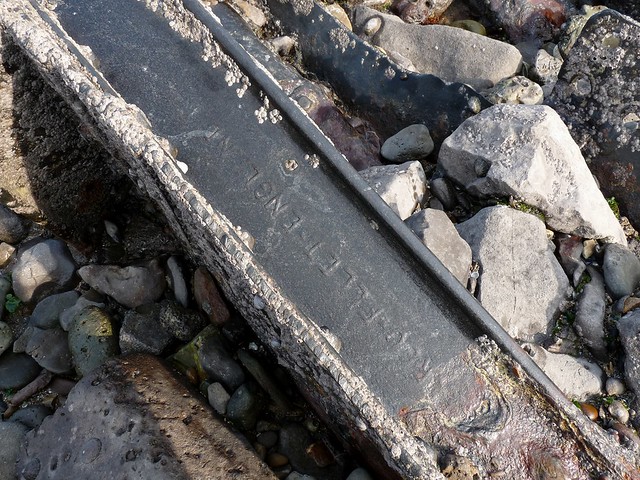Way back in 2009 I stumbled across the impressive remains of the shipwrecked Wittezee, a Rotterdam registered tug which came to grief along the Gower coastline in 1940. That chance find amongst the rocks of Overton Mere opened up a whole new area of interest for me and spawned the website Gower Shipwrecks. Slowly but surely I have been researching other wrecks around the peninsula and visiting each location to hunt out and catalogue any remains or artefacts linked to their stories. It was therefore no surprise that on returning to Overton last weekend one of my key aims was to check on the wreck that I had last photographed over two years ago.
At first all looked well but then I spotted the brand new outfall pipe that had been installed by Welsh Water and which cut right through the heart of the bay. Although relatively small and well disguised in itself, the machinery used to install it had necessitated the building of a temporary road across the rocks. In doing so it would appear that all of the remains I had originally photographed, some of which are show above, had been removed, no doubt to a fate that does not befit the history associated with them. Clearly I was less than impressed with this turn of events and started a search along the coastline in the hope that some evidence of the Wittezee still remained. To begin with all we found were small sections of steel which had no doubt been ripped from her hull as she broke up, but then we stumbled across a tangled mass of steel cable that must presumably have been part of her pulling gear.
Moving on we were fortunate that our visit had coincided with a low tide as it meant that we were able to walk much further out onto the rocks than previously. As we stepped down into one particularly deep ravine we could not have imagined what we would find. Spread before us was the actual hull of the Wittezee lying on its side, battered and with large sections removed for scrap but largely present from stern to bow.
The power of the sea has in places moulded the sheet steel to perfectly match the underlying rock formations, a testament to the power that once tore this ship apart. Elsewhere it almost appears as if the metal has itself been turned to rock given how every surface is encrusted with the same marine life. Those areas that remain clear reveal surprising details such as the makers stamp on one of the hull ribs.
To find that those first remains are now gone is sad, but to have discovered the hull is enough compensation to lessen the disappointment. Given their size and position it is likely that the Wittezee will have a presence on the Gower coastline for many years to come, and I for one am very happy about that.










5 Comments
TexWisGirl · November 18, 2011 at 12:13 am
i bet it was neat to see it 'morphing' into its environs – with shape and form.
holdingmoments · November 18, 2011 at 12:13 pm
Great to find more of the old ship Adam, but I can't help feeling how sad it is, for it to just rot away like that.
theconstantwalker · November 19, 2011 at 10:23 pm
A wonderful post to read Adam.. It's lovely to see you recording the old wrecks around your coast.
Many thanks for sharing…
Adam Tilt · December 3, 2011 at 12:02 am
TexWisGirl – certainly was. Not seen anything quite like it before.
Keith – it is, and it's just one of many along this coast.
Andrew – thanks. I thought I'd better record them before they are all gone.
Frances Bevan · December 6, 2011 at 2:07 pm
I'm interested in the stories about Gower wrecks as they frequently appear in letters exchanged between the Bevan family at Gower and Llandudno. I will soon be adding letters talking about a Norweggian Barque that came ashore under Slade Cliff in January 1879 – see http://www.georgebevan.blogspot.com